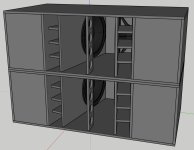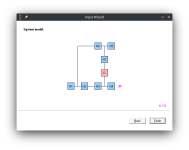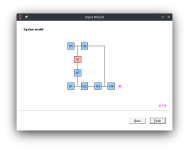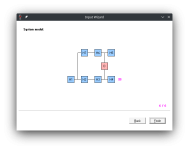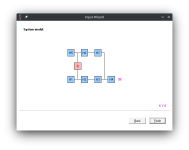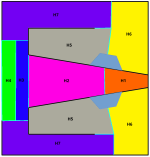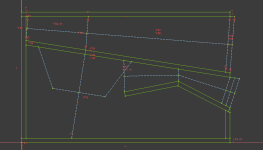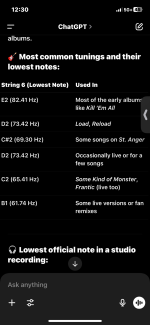Have you ever looked at a spectral analysis of the low A on a piano (or many of the common key sounds like clav or organ), or an open B string of a five string bass guitar? Basically zero fundamental on the case of the piano, and not a lot (relative to the second harmonic) of fundamental on the bass guitar.That's a concept I will never understand when a standard 88 key piano goes to 27.5hz.
Skip 6 mins in to this video to see C1 (32.7Hz) analysed, the fundamental is 20 or 40dB down on the first harmonic depending on the piano sampledHave you ever looked at a spectral analysis of the low A on a piano
They look like a similar offset driver horn with rear vented chamber. Really clever to make them as dual enclosures, so the driver can be mounted from the front, but compression ratio can be kept high.
The low tuned side looks like a steep tapered TL shape (fancy Bass reflex) inside with lots of bracing. We used to geek out in horn response looking at making that more of an ODTL or similar Big vented reflex (with strategic driver offset)
Last edited:
What plans are thoseI did a quick model of dual bins, where the drivers can be accessed from the front, without the need for an access door. Pretty sick looking!
After a bit of experimentation I came up with this.
As you probably can tell, very much inspired by Cain Duyts' designs.
Designed around B&C 12NDL76 4ohm
Drivers can be installed via the horn.
Tuned for SPL. I know it doesn't hit 40hz. That is by design. I am still running on battery power and need all the SPL and efficiency I can get. At lower SPL levels I can always plug one or two of the ports and adjust the DSP for a lower tune.
I have not added bracing yet.
Port air speed is a bit high at war levels, but I don't min a but of chuffing at this SPL level. Everything will be rattelling anyway. Again, everything in the name of SPL and efficiency in this design.
Do you guys think the ports going around a corner will be a problem at those high velocities?
There are probably a few mistakes in there, it's by no means a finished and polished design.
@LORDSANSUI your freeCAD software is amazing. Thanks!
As you probably can tell, very much inspired by Cain Duyts' designs.
Designed around B&C 12NDL76 4ohm
Drivers can be installed via the horn.
Tuned for SPL. I know it doesn't hit 40hz. That is by design. I am still running on battery power and need all the SPL and efficiency I can get. At lower SPL levels I can always plug one or two of the ports and adjust the DSP for a lower tune.
I have not added bracing yet.
Port air speed is a bit high at war levels, but I don't min a but of chuffing at this SPL level. Everything will be rattelling anyway. Again, everything in the name of SPL and efficiency in this design.
Do you guys think the ports going around a corner will be a problem at those high velocities?
There are probably a few mistakes in there, it's by no means a finished and polished design.
@LORDSANSUI your freeCAD software is amazing. Thanks!
Attachments
-
 Dual bin spreadsheet.JPG36.5 KB · Views: 29
Dual bin spreadsheet.JPG36.5 KB · Views: 29 -
 Dual bin.JPG24.1 KB · Views: 32
Dual bin.JPG24.1 KB · Views: 32 -
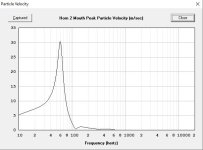 Dual bin port velocity max SPL.JPG31.1 KB · Views: 31
Dual bin port velocity max SPL.JPG31.1 KB · Views: 31 -
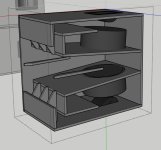 Dual bin open.JPG50 KB · Views: 36
Dual bin open.JPG50 KB · Views: 36 -
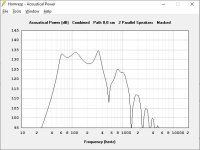 Dual bin max SPL.JPG42.1 KB · Views: 30
Dual bin max SPL.JPG42.1 KB · Views: 30 -
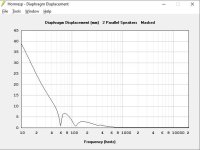 Dual bin max SPL displacement.JPG36.2 KB · Views: 27
Dual bin max SPL displacement.JPG36.2 KB · Views: 27 -
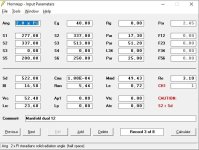 Dual bin hornresp.JPG53.8 KB · Views: 31
Dual bin hornresp.JPG53.8 KB · Views: 31 -
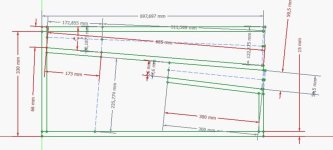 Dual bin blueprint.JPG44.9 KB · Views: 33
Dual bin blueprint.JPG44.9 KB · Views: 33 -
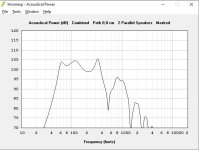 Dual bin 1w SPL.JPG40.2 KB · Views: 30
Dual bin 1w SPL.JPG40.2 KB · Views: 30
Port air speed is a bit high at war levels
Check the attachment in the post #172, it may give you some inspiration to reduce particle velocity at mouth. Just venture style, just one more peace of wood.
your freeCAD software is amazing
I'm happy you liked the tool.
Just be careful, the bend you introduced in the vent pointing it back to front chamber changed the model, it's not Compounded Horn anymore, now it became "Paraflex" and to improve accuracy you need to make some changes on it.
You can check other Paraflex model to understand how the model works, and adjust your self the models or ask for some help.
Attached you can find tome Praflex System Model to choose witch model fits better your needs now.
Attachments
Thanks for those ideas. I will mess around with that.Check the attachment in the post #172, it may give you some inspiration to reduce particle velocity at mouth. Just venture style, just one more peace of wood.
I'm happy you liked the tool.
Just be careful, the bend you introduced in the vent pointing it back to front chamber changed the model, it's not Compounded Horn anymore, now it became "Paraflex" and to improve accuracy you need to make some changes on it.
You can check other Paraflex model to understand how the model works, and adjust your self the models or ask for some help.
Attached you can find tome Praflex System Model to choose witch model fits better your needs now.
Do you really think that that slight change in port angle and placement will make a significant difference?
I guess a paraflex is a compound horn, where the low frequency horn fires into the high frequency horn? Well in this case the port fires into the very edge of the horn, so I guess it’s a grey area? Also I am not aware of a paraflex design that has a rear chamber?
Regarding the venturi port, I could probably just angle the panels, so that the corner becomes the narrow part, that would require no extra panels, just a slight headache of having strange shaped bracing. But would be cool if it worked.
Paraflex connects the resonator exits together and gives you that potential phase issue that seperating them a bit sort of avoids or dilutes out into the room ?
I wonder if connecting them together is more prone to ringing if they don’t both go into resonace at the same frequency (3 x Fb ) as you can see in horn response.
The longside is in resonance (velocity max at exit) , while the short side isn’t and the air is a bit contradictory at that point, the result might be so akward that it becomes audible. It’s obvious in a measurement either way
I wonder if connecting them together is more prone to ringing if they don’t both go into resonace at the same frequency (3 x Fb ) as you can see in horn response.
The longside is in resonance (velocity max at exit) , while the short side isn’t and the air is a bit contradictory at that point, the result might be so akward that it becomes audible. It’s obvious in a measurement either way
Do you really think that that slight change in port angle and placement will make a significant difference?
The best way to know is trough simulation.
Taking the Paraflex Type 1 model and applying it to your design we find the attachment #2.
At this stage you may find issues because Hornresp software has some constrain and will not allow you to accurately represent this design due to the flared segments, to fix this issue you can use different software like Akabak or remove the flares. Other option is to keep the model as Manifold aligned with CH2 model keeping front and back outputs separated and so you have freedom for the flares.
Each person has individual quality targets, me and other in this forum will recommend to simulate designs and build them as accurate as possible to accomplish what you planned. If you deviate you can be surprised negatively or positively, it became guessing and lottery.
I guess a paraflex is a compound horn, where the low frequency horn fires into the high frequency horn? Well in this case the port fires into the very edge of the horn, so I guess it’s a grey area? Also I am not aware of a paraflex design that has a rear chamber?
Manifold design is a compound horn, this is the reason the model inside hornresp is called CH2 = Compound Horn Type 2.
Just go for some abstractions, Chamber, segments, they can be the same thing or different one, it depends from the context and the model.
Take a look in the the models vbslot1-a and vbslot1-b in the link below, the design is the same, the only difference is how the models were created for the simulation.
While one consider rear chamber with vent, the other has 3 segments. The model "b" has one big advantage over "a" that is the influence of driver position in the output.
https://freeloudspeakerplan.rf.gd/pages/vbslot1-a.htm
https://freeloudspeakerplan.rf.gd/pages/vbslot1-b.htm
Attachments
Regarding the venturi port,
Check attached image for inspiration.
Attachments
Have you ever looked at a spectral analysis of the low A on a piano (or many of the common key sounds like clav or organ), or an open B string of a five string bass guitar? Basically zero fundamental on the case of the piano, and not a lot (relative to the second harmonic) of fundamental on the bass guitar.
The point is the instrument can produce the note. If you are an audiophile, then I would think you want your system to play every note a standard instrument can play.
And speaking of instruments, what instrument does Metallica play that produces a 30hz note?
Skip 6 mins in to this video to see C1 (32.7Hz) analysed, the fundamental is 20 or 40dB down on the first harmonic depending on the piano sampled
I'm watching the video now on my laptop.
It would be interesting to see and hear those same C1 strikes with a <100hz low pass filter in place.
If you fellas listen to your systems with your subwoofer playing wide open for normal everyday listening, then mo' power to ya.
I asked my mom
🤣😂
Well dayum, YOU don't need a SUBwoofer. A midbass bin will do.
Metallica's bass player has alternated between 4 and 5 string basses, the low "B" on a five string bass is 30.87 Hz.what instrument does Metallica play that produces a 30hz note?
Low E on a 4 string bass is 41.2 Hz, though some song tunings may drop the "E" to a "D", 36.7Hz.
Regardless of genre or instrument, the low fundamental frequencies are seldom mixed as loud as the second harmonics.
Arguably the whole of And Justice for All had no bass in the mix 😂. As @weltersys noted, a low B on a five string bass has a fundamental close enough to 30hz. Lars’ kick drum potentially has some content in the 30s depending on the album.The point is the instrument can produce the note. If you are an audiophile, then I would think you want your system to play every note a standard instrument can play.
And speaking of instruments, what instrument does Metallica play that produces a 30hz note?
I’m primarily a s bass player, and also a semi professional luthier (Booka Bass on YouTube or instagram). The best sounds I can coax out of my instruments (some of which are tuned down to F#0) are found through using a resonant high pass filter, usually centred an octave above the the lowest five notes on the bass. In other words, filtering out the fundamental and emphasising the second harmonic.
Curiously, adjustable high pass filters on bass amps are becoming increasingly common, with players using them to “clean up” the low end.
For my box designing purposes (including the BP6S boxes I'm in the process of making), 40hz performance is just fine. My instrument makes the lowest frequencies in the band, and my hpf is generally set somewhere north of 46hz.
To each his own, of course. The above is just my experience and taste.
- Home
- Loudspeakers
- Subwoofers
- Case for Discussion - Would a Single driver Manifold/MTB be better than Tapped Horn?
